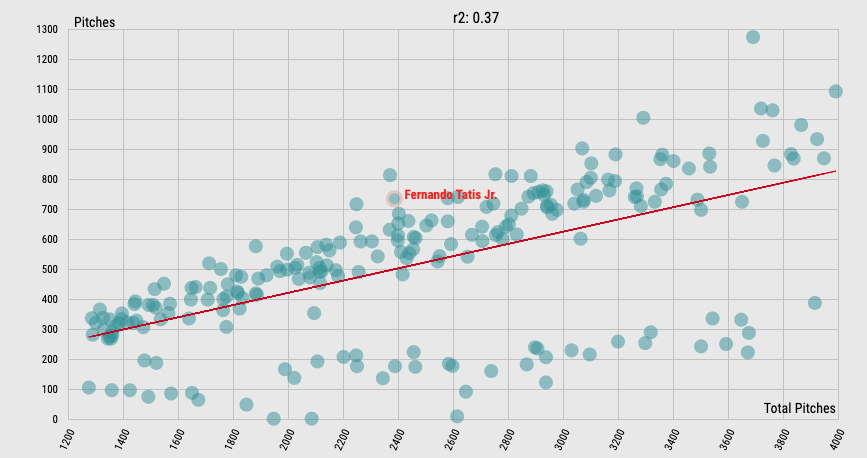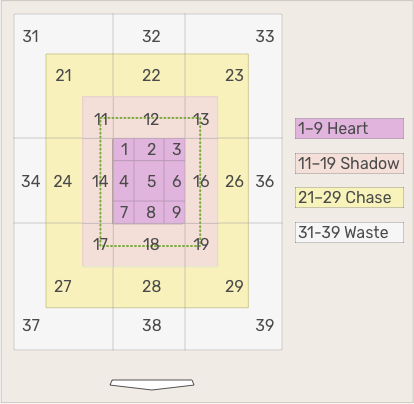Most folks are probably aware enough to know that accepting a COVID-shortened 2020 baseball season and its results as hard evidence is bad business. It just is.
60 games? Not much. Unique circumstances? The uniquest! There were simply too many things beyond the realm of normalcy that you have to consider when placing value on what the 2020 season says about any specific player, positive or negative. As it pertains to Fernando Tatis Jr., there was much more positive than negative.
There may not be a player more predestined for stardom in Major League Baseball than Tatis. He possesses all five tools (contact, power, speed, defense, and arm strength) and perhaps even a sixth one if you consider swagger to be a trait on the field, which I absolutely do. In the 59 games he played in 2020, Tatis might have proven that looking good, feeling good, and playing good is an exact science.
| Games | Avg. Exit Velocity | Hard-Hit Rate | Barrels | Barrels per BBE % | |
| 2019 | 84 | 90.4 mph (69th) | 44.1% (54th) | 30 (109th) | 13.2% (23rd) |
| 2020 | 59 | 95.9 mph (1st) | 62.2% (1st) | 32 (1st) | 19.5% (2nd) |
I mean, these aren’t upticks of the garden variety. This is an elite player being an elite player, consistently. Turning 22 this coming January, Tatis’ gaudy batted-ball results paved the way for a .277/.366/.551 slash, 149 wRC+, and .392 wOBA. If there’s a more prodigious offensive shortstop in the world, I’d gladly entertain names for debate because this is as good as it gets.
Tatis’ entire 2020 picture, in spite of a smaller canvas, does nothing to disprove what we already knew; the dude is really, really good. Even so, we wouldn’t be doing our due diligence if we didn’t acknowledge that Tatis’ demonstrative first half was followed by a second half that was a little less so.
| PA | BA | wRC+ | wOBA | BABIP | Pull % | Hard-Hit % | K% | BB% | |
| First 30 games | 134 | .314 | 182 | .442 | .352 | 48.2% | 60.2% | 26.1% | 10.4% |
| Last 29 games | 123 | .236 | 113 | .338 | .263 | 40.7% | 49.4% | 21.1% | 10.6% |
Tatis’ first 30 games this season catapulted him to superstar status. He led all of baseball in categories such as fWAR (2.1), home runs (12), and runs against replacement (22.0).
While it’s fairly clear that Tatis was still a more than capable everyday player during the month of September, his production tapered off. His weighted on-base average fell more than a hundred points, while his batting average on balls in play nearly did as well. His pull rate also depreciated in the second-half, falling nearly 8%.
RHH Inside Pitches Seen 2019-20

Credit: Baseball Savant
Since debuting in 2019, Tatis has been among the right-handed leaders in pitches seen on the inner-half of the plate. Over the past two seasons, more than 30% of his pitches seen have been located inside, the fourth-most among righties in that span. His quantifiable success in that area of the zone was evident as a rookie, recording a tremendous .222 isolated power on inside pitches.
As one would expect, his meteoric 2020 exit velocity numbers also saw jumps in the inner area of the zone, as his average EV rose significantly from 86.9 mph in 2019 to 92.8 mph in 2020. However, Tatis hardly benefited from his work on the inside half of the plate, posting a middling .159 ISO on inside pitches in his 59 games this season despite the massive EV spike. In comparison, the 10 qualified righties with higher EV results on inside pitches in 2020 averaged an ISO of .380.
Pitchers, however, did seem to notice that Tatis’ batted-ball luck on the inner-half of the plate was a ticking time-bomb, as the oh-so-small sample size of 2020’s second-half saw a change in how pitchers attacked him.
Tatis saw a decline in fastballs offered from the first to the second half this past season, as that number depressed from 59.5% to 56.9%. That margin was made up by opposing pitchers’ slider usage, where that figure jumped from 15.6% to 18%. In correlation, Tatis’ swing rate against sliders went up nearly 4% over the final month and change.
As it became a pattern, Tatis actually hit sliders HARDER over this span than he did during his first 30 games. However, that doesn’t explain why Tatis’ batted-ball success took such a sharp downward turn. We can’t say Tatis struggled at the plate because his average exit velocity (95.5 MPH) in the second half of 2020 was actually the best number among every-day players.
In a strange sort of way, this slight regression could be considered a result of the effect he’s created on pitchers when he steps into the batter’s box. Pitchers quickly recognized the Mayor of Slam Diego is one hell of a statesman, and they’ve pitched him accordingly.

Above is what Baseball Savant calls attack zones. Each portion of the plate is broken down into four zones, known as the heart, shadow, chase, and waste areas of the plate. The “heart” of the zone includes pitches with a 100% strike rate, while the “shadow” area of the zone encompasses pitches with a 50-50 chance of being called a strike.
Over Tatis’ first 114 games, 39.9% of his pitches seen had been classified as pitches in the shadow zone, a figure that placed him among the bottom percentile in the league. That stat rose over his last 29 games to nearly 45%, while the pitch percentage of the three other zones all lowered. Every pitch requires a split-second decision, and pitchers did well to force Tatis into making tougher choices.
Tatis is a hitter that continued to hit everything he saw really hard, not only when his numbers proved it, but also when they didn’t. I’d venture to say that his second half was a result of him being approached more so with a sense of caution, and it’s no mystery better pitches tend to lead to worse results at the plate. Considering he saw more sliders in general and better-located fastballs away from him, both created more batted ball events away from the pull side and a higher frequency of ground balls, which may explain the decrease in pull rate in Tatis’ latter half of 2020.
As it stands, we’re dealing with an already established superstar shortstop entering his age-22 season in 2021, a player whose “slump” can be equated to a 113 wRC+. There are plenty of guys in the big leagues that would latch onto that figure for 10-plus years. Even in the midst of his worst month as a professional, he was still producing at a level above a majority of his peers.
I found the subject of Tatis’ supposed struggle intriguing because of course it was. How does one go from being an MVP shoo-in to on the outside looking in? Typical regression perhaps, but I thought there was going to be a reason for at least some skepticism.
Instead, we’ve learned pitchers are growing weary of Tatis, and perhaps in record time.
Photo by Brian Rothmuller & Andrew Dieb/Icon Sportswire/Icon Sportswire | Adapted by Michael Packard (@designsbypack on Twitter & IG)

